What They Are and What You Can Do About Them
Reposting or copies of this article must credit the author and show copyright.
 The term
“puppy mill” is used more and more frequently today in the media, and often
it has a different meaning depending on who is using the term. It
depends greatly on the writer’s point of view as to what is considered
to be “reputable” dog breeding. For the purposes of this article,
I consider a reputable breeder to be someone who breeds only for the betterment
of the dog breed. Such a person very carefully picks only the best
champion stock for breeding, and screens all breeding dogs for genetic
defects. They very rarely make a profit from their operation, and
more often, take a loss. Their primary motivation is to produce better
dogs, which are as close to the breed standard as possible.
The term
“puppy mill” is used more and more frequently today in the media, and often
it has a different meaning depending on who is using the term. It
depends greatly on the writer’s point of view as to what is considered
to be “reputable” dog breeding. For the purposes of this article,
I consider a reputable breeder to be someone who breeds only for the betterment
of the dog breed. Such a person very carefully picks only the best
champion stock for breeding, and screens all breeding dogs for genetic
defects. They very rarely make a profit from their operation, and
more often, take a loss. Their primary motivation is to produce better
dogs, which are as close to the breed standard as possible.
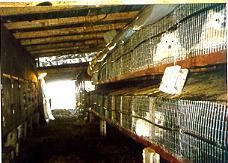
A puppy miller, on the other hand, breeds only for profit. They
breed dogs without any consideration for genetic defects or “faults” as
defined by the breed standard. They vary widely in their treatment
of their breeding dogs and puppies. The worst examples of puppy millers
cruelly confine their breeding animals in cramped, horribly unsanitary
conditions and give little or no veterinary care to them. These are
the places that are featured in the media, such as the Dateline NBC show
that aired this past April. Dogs that are rescued from these conditions
are often the worst we see in rescue, in terms of physical and emotional
health. There are also puppy mills who keep their breeding dogs clean
and vetted. These millers at least offer some level of health to
their dogs, if not a loving “home” environment. How is it that I
can call all these people “puppy millers” when their operations are so
different? To me, the bottom line of what is a mill and what isn’t
is that a mill produces purebred dogs for profit only and turns out poor
quality and/or sick puppies as a result.
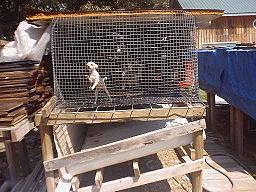 So,
how do you know a puppy mill puppy when you see one? For one thing,
consider its source. Pet shops are a huge market for puppy mill puppies.
Just by looking at that cute little puppy in the window you would never
guess that his mother is locked in a puppy mill cage in a Midwestern state,
barely able to keep herself alive, let alone care for her puppies.
The pet store may claim that they buy from only local breeders. That
may be true, but what they don’t tell you is that they also buy from brokers
who buy puppies from mills all over the Midwest. Pet stores may also
claim they only deal with USDA licensed breeders. The fact is, being
USDA licensed is a huge red flag that the breeder is a puppy mill.
Breeders only have to get a USDA license if they sell wholesale to pet
shops or brokers. What’s even worse is that a USDA license means
practically nothing. There are only 65 USDA inspectors to cover 11,000
facilities per year. Even when an inspection is done and violations
of the Animal Welfare Act are found, generally nothing is done or there
is only a minimal fine. Kim Townsend of NoPuppyMills.com
has excellent information on her website about just how shoddy the USDA
inspections really are.
So,
how do you know a puppy mill puppy when you see one? For one thing,
consider its source. Pet shops are a huge market for puppy mill puppies.
Just by looking at that cute little puppy in the window you would never
guess that his mother is locked in a puppy mill cage in a Midwestern state,
barely able to keep herself alive, let alone care for her puppies.
The pet store may claim that they buy from only local breeders. That
may be true, but what they don’t tell you is that they also buy from brokers
who buy puppies from mills all over the Midwest. Pet stores may also
claim they only deal with USDA licensed breeders. The fact is, being
USDA licensed is a huge red flag that the breeder is a puppy mill.
Breeders only have to get a USDA license if they sell wholesale to pet
shops or brokers. What’s even worse is that a USDA license means
practically nothing. There are only 65 USDA inspectors to cover 11,000
facilities per year. Even when an inspection is done and violations
of the Animal Welfare Act are found, generally nothing is done or there
is only a minimal fine. Kim Townsend of NoPuppyMills.com
has excellent information on her website about just how shoddy the USDA
inspections really are.
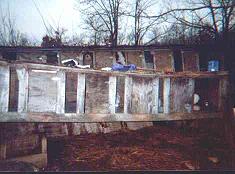 In
the event a miller runs such a horrendous operation that he loses his USDA
license, there are still plenty of ways for him to sell his puppies.
Believe it or not, he can still sell to pet shops, if he gives co-ownership
of the puppies to the pet shop owner. Then, the miller is not wholesaling
his puppies; he is retailing them. Retail puppy sales do not require
USDA license. Flea markets are another popular place for puppy sales.
They rely on the puppies’ cute faces to sell themselves, and by the time
the new owner figures out their puppy is terribly sick, the seller is long
gone. Many millers advertise in their local newspapers also, or they
may partner with another person who will sell their mill puppies from their
home. Sometimes the miller is so bold as to list all the breeds they
have in one ad. Other times they will fool you into thinking they
only have one breed by running separate ads for each breed. When
you contact the people about their ad, they may give you a reason why they
will be out in your area and offer to bring the puppy to you or meet you
somewhere. If you actually get to visit their home, they will only
bring out the breed you are interested in. You won’t be allowed to
see the parents, because the parents are either out back, covered with
filth and reeking of disease, or they aren’t even there.
In
the event a miller runs such a horrendous operation that he loses his USDA
license, there are still plenty of ways for him to sell his puppies.
Believe it or not, he can still sell to pet shops, if he gives co-ownership
of the puppies to the pet shop owner. Then, the miller is not wholesaling
his puppies; he is retailing them. Retail puppy sales do not require
USDA license. Flea markets are another popular place for puppy sales.
They rely on the puppies’ cute faces to sell themselves, and by the time
the new owner figures out their puppy is terribly sick, the seller is long
gone. Many millers advertise in their local newspapers also, or they
may partner with another person who will sell their mill puppies from their
home. Sometimes the miller is so bold as to list all the breeds they
have in one ad. Other times they will fool you into thinking they
only have one breed by running separate ads for each breed. When
you contact the people about their ad, they may give you a reason why they
will be out in your area and offer to bring the puppy to you or meet you
somewhere. If you actually get to visit their home, they will only
bring out the breed you are interested in. You won’t be allowed to
see the parents, because the parents are either out back, covered with
filth and reeking of disease, or they aren’t even there.
Another tool of puppy millers to make their dogs sound well bred is American Kennel Club (AKC) papers. The AKC is only a registry, and as such, has no regulatory ability over breeding practices. It exists to track the parentage of purebred dogs. Ever since its inception, a breeder was on their honor to be honest about the parentage of the puppies they produce. Mills were able to register anything, even cross breeds, as purebred dogs. An uneducated puppy buyer wouldn’t even know the difference. Another common practice was bunching puppies together. The AKC charges a fee per litter, not per puppy. If you have two females of the same breed with litters at the same time, even if the ages of the puppies are quite different, register them as one litter and save a little money. Another common practice was to add a few extra puppies to a litter so that you can register puppies for your friend whose AKC privileges have been revoked. Things are changing, now, however. The AKC has now started requiring DNA testing for breeding dogs and puppies, which increases the costs to the miller dramatically, and vastly increases the chances of them getting caught for their dirty dealings and losing AKC privileges. Does this deter the millers? Not really. They just turn to different registries, like the Continental Kennel Club (CKC), America’s Pet Registry (APR), and others. Purebred papers from these sources are not worth the paper they’re printed on. Millers don’t even have to prove they own the dogs they bred, or that they are the breed they claim. These registries will even register mixed breeds, like cock-a-poos!
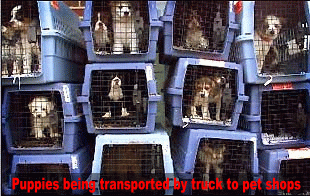 What
does all this mean to you? A puppy that comes down with distemper
or parvo is your worst nightmare come true. Your precious new puppy
may rack up vet bills totalling in the thousands, and still end up dying.
It’s only common sense to realize that puppy mills, which care only about
profit, may skip costly vaccinations that could have prevented your puppy’s
death. Health certificates for the puppies can be easily forged by
a vet who is in alliance with millers. Even if the puppy did receive
its shots before it left the breeder, pet stores rarely will give any veterinary
care to the puppies they have after they receive them. People who
have worked in pet shops speak of “dying rooms” where the sick and dying
puppies are put until they have died and can be thrown like so much garbage.
They certainly couldn’t keep that sick puppy out in full view of the public.
What
does all this mean to you? A puppy that comes down with distemper
or parvo is your worst nightmare come true. Your precious new puppy
may rack up vet bills totalling in the thousands, and still end up dying.
It’s only common sense to realize that puppy mills, which care only about
profit, may skip costly vaccinations that could have prevented your puppy’s
death. Health certificates for the puppies can be easily forged by
a vet who is in alliance with millers. Even if the puppy did receive
its shots before it left the breeder, pet stores rarely will give any veterinary
care to the puppies they have after they receive them. People who
have worked in pet shops speak of “dying rooms” where the sick and dying
puppies are put until they have died and can be thrown like so much garbage.
They certainly couldn’t keep that sick puppy out in full view of the public.
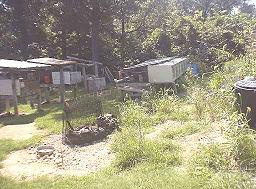 Even if the
mill puppy doesn’t get sick right away, there may be some genetic disease
lurking within his body. Which is more tragic, an 8 week old puppy
who dies of parvo, or a 1 year old dog who dies from a hole in his heart?
How would you feel if the dog you dearly love was killed or struck down
with a painful or debilitating disease in the prime of life? You’d
probably be pretty angry about the poor breeding practices that produced
him, and well you should be. It’s true, not every genetic disease
can be screened for, but a responsible breeder will make every attempt
to identify these problems if possible. They will either certify
their puppies to be free from genetic defect or they will wait until their
dogs are several years old before breeding them, so that late onset diseases
will have appeared by then. Another group of genetic diseases are
associated with so-called “rare” colors and patterns. It’s a known
fact that blues and isabellas have skin and coat problems. Millers
breed these colors because they can increase their profits if they convince
buyers that the pups are rare. This is an area where the public can
exercise a little common sense. If a color is “rare”, there is probably
a reason why. Either it is an improper color for the breed and as
such is disqualified from showing, or it has health problems associated
with it that responsible breeders do not want to propagate. The double
dapple pattern is another example of this. Double dapples are frequently
born with congenital blindness and/or deafness. The trend now among
mills is to produce puppies that have two patterns, as in dappled piebalds.
This practice is very detrimental to the breed since it makes the patterns
difficult to track. AKC only allows one pattern to be chosen for
a pup, so years down the road there may be recessive genes that pop up
without warning. Since piebald and double dapple both produce white
in the coat, and double dapples can have such serious congenital defects,
it is important to keep them separate or it may not be possible to tell
which pattern an offspring has.
Even if the
mill puppy doesn’t get sick right away, there may be some genetic disease
lurking within his body. Which is more tragic, an 8 week old puppy
who dies of parvo, or a 1 year old dog who dies from a hole in his heart?
How would you feel if the dog you dearly love was killed or struck down
with a painful or debilitating disease in the prime of life? You’d
probably be pretty angry about the poor breeding practices that produced
him, and well you should be. It’s true, not every genetic disease
can be screened for, but a responsible breeder will make every attempt
to identify these problems if possible. They will either certify
their puppies to be free from genetic defect or they will wait until their
dogs are several years old before breeding them, so that late onset diseases
will have appeared by then. Another group of genetic diseases are
associated with so-called “rare” colors and patterns. It’s a known
fact that blues and isabellas have skin and coat problems. Millers
breed these colors because they can increase their profits if they convince
buyers that the pups are rare. This is an area where the public can
exercise a little common sense. If a color is “rare”, there is probably
a reason why. Either it is an improper color for the breed and as
such is disqualified from showing, or it has health problems associated
with it that responsible breeders do not want to propagate. The double
dapple pattern is another example of this. Double dapples are frequently
born with congenital blindness and/or deafness. The trend now among
mills is to produce puppies that have two patterns, as in dappled piebalds.
This practice is very detrimental to the breed since it makes the patterns
difficult to track. AKC only allows one pattern to be chosen for
a pup, so years down the road there may be recessive genes that pop up
without warning. Since piebald and double dapple both produce white
in the coat, and double dapples can have such serious congenital defects,
it is important to keep them separate or it may not be possible to tell
which pattern an offspring has.
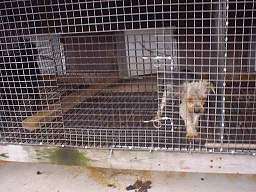 Let’s
assume now that your pet store or flea market puppy doesn’t have any contagious
disease or genetic defect. You might think then that your puppy is
just as well off as if it had come from a responsible breeder. Sadly,
this is not true. In addition to the physical health problems of
puppies coming from mills, there are emotional problems very often too.
These puppies are raised with very little or no human contact until they
are suddenly yanked away from their mothers and sold. They are usually
sold at a very young age because keeping the puppies additional weeks would
eat into the miller’s profits. Without proper socialization during
the critical period of 3-10 weeks of age, the puppies may become withdrawn
and distrustful of people. During this critical period, it is absolutely
essential that the puppies receive contact with people if they are going
to make good pets later on. Without this socialization, the puppies
will be fearful of people and will remain that way throughout their life.
Many times puppies that are raised in isolation from people will never
be able to bond with a human. Their fear of people can manifest itself
in all manner of neurotic behaviors such as fear biting and submissive
urination. Long term isolation from other dogs is also a reason why
so many dogs develop obsessive behaviors like spinning and pacing.
In rescue we see many adult dogs that have lived their entire lives in
puppy mills. They are the worst behavioral cases we get. Occasionally,
their fears are so deep-rooted that there is nothing that can be done to
cure it. To me, this is the worst part of the puppy mill industry.
The dogs are treated as a commodity rather than as a cherished pet.
They merely exist rather than having a life. They will never know
the joy of chasing a ball, or lying on a sofa watching TV. They’ll
never have any “goforarides” or plush squeaky toys to shred. They
suffer and die without ever knowing love.
Let’s
assume now that your pet store or flea market puppy doesn’t have any contagious
disease or genetic defect. You might think then that your puppy is
just as well off as if it had come from a responsible breeder. Sadly,
this is not true. In addition to the physical health problems of
puppies coming from mills, there are emotional problems very often too.
These puppies are raised with very little or no human contact until they
are suddenly yanked away from their mothers and sold. They are usually
sold at a very young age because keeping the puppies additional weeks would
eat into the miller’s profits. Without proper socialization during
the critical period of 3-10 weeks of age, the puppies may become withdrawn
and distrustful of people. During this critical period, it is absolutely
essential that the puppies receive contact with people if they are going
to make good pets later on. Without this socialization, the puppies
will be fearful of people and will remain that way throughout their life.
Many times puppies that are raised in isolation from people will never
be able to bond with a human. Their fear of people can manifest itself
in all manner of neurotic behaviors such as fear biting and submissive
urination. Long term isolation from other dogs is also a reason why
so many dogs develop obsessive behaviors like spinning and pacing.
In rescue we see many adult dogs that have lived their entire lives in
puppy mills. They are the worst behavioral cases we get. Occasionally,
their fears are so deep-rooted that there is nothing that can be done to
cure it. To me, this is the worst part of the puppy mill industry.
The dogs are treated as a commodity rather than as a cherished pet.
They merely exist rather than having a life. They will never know
the joy of chasing a ball, or lying on a sofa watching TV. They’ll
never have any “goforarides” or plush squeaky toys to shred. They
suffer and die without ever knowing love.
In order to stop the mills, several things about our society must change. The first thing and most important thing, is the USDA must be cleaned up. There need to be many more inspectors and those inspectors should actually go out and enforce the Animal Welfare Act like they are supposed to do. No more “warnings” for serious violations that go unchanged for years on end! We need to have a zero tolerance policy for animal cruelty in this country! Not just for the puppy mills, but for all America. Our society has let animal abusers get away with their crimes with nothing but a slap on the wrist for far too long. We need laws passed in every state that makes abusing an animal a felony. Write your Senators and Representatives about your outrage at the horrible animal abuse that is allowed to happen in this country. Make your voice be heard!
Second, inform everyone you now about buying from responsible breeders. Tell them that to find a responsible breeder, they should ask vets, go to dog shows, or ask friends for referrals. Explain to them that a responsible breeder will want to check them out as thoroughly as they check out the breeder. A breeder who doesn’t care where their puppy is going is either a mill or no better than one. A responsible breeder will offer health guarantees with their puppies. They will place their puppies on a contract that states the buyer will return the puppy to them if they can’t keep it. They will do everything they can to ensure that the buyer and puppy are completely happy with each other.
Third, boycott pet stores that sell puppies. We need to send a clear message to pet store owners that we are fed up with the large scale abuse of dogs and we want it stopped! Unfortunately, just taking away the American market for mill puppies is not enough to stop them. The mills will simply divert their business to foreign markets. That’s why it is absolutely essential to changing the laws. There are many organizations in existence who are dedicated to this task. See the links section below to visit their sites and get involved! The only way the puppy mills will ever be stopped is if all Americans make it clear that we will not tolerate this any longer!
Is this the way a dog should have to live it's life?
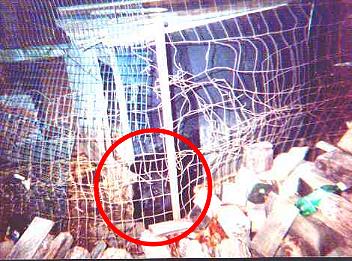 No
love, no warmth, no kindness and only considered a comodity. Think
of all the dogs like this one below and tell yourself you can look the
other way. Think of him or her when you see that puppy in the pet
shop window and how miserable and unhappy his or her life truly is.
Think of this face and get involved. This could be your puppy's
mother.
No
love, no warmth, no kindness and only considered a comodity. Think
of all the dogs like this one below and tell yourself you can look the
other way. Think of him or her when you see that puppy in the pet
shop window and how miserable and unhappy his or her life truly is.
Think of this face and get involved. This could be your puppy's
mother. ![]()